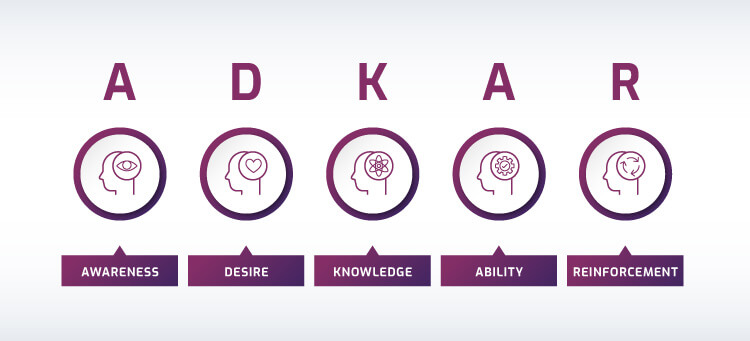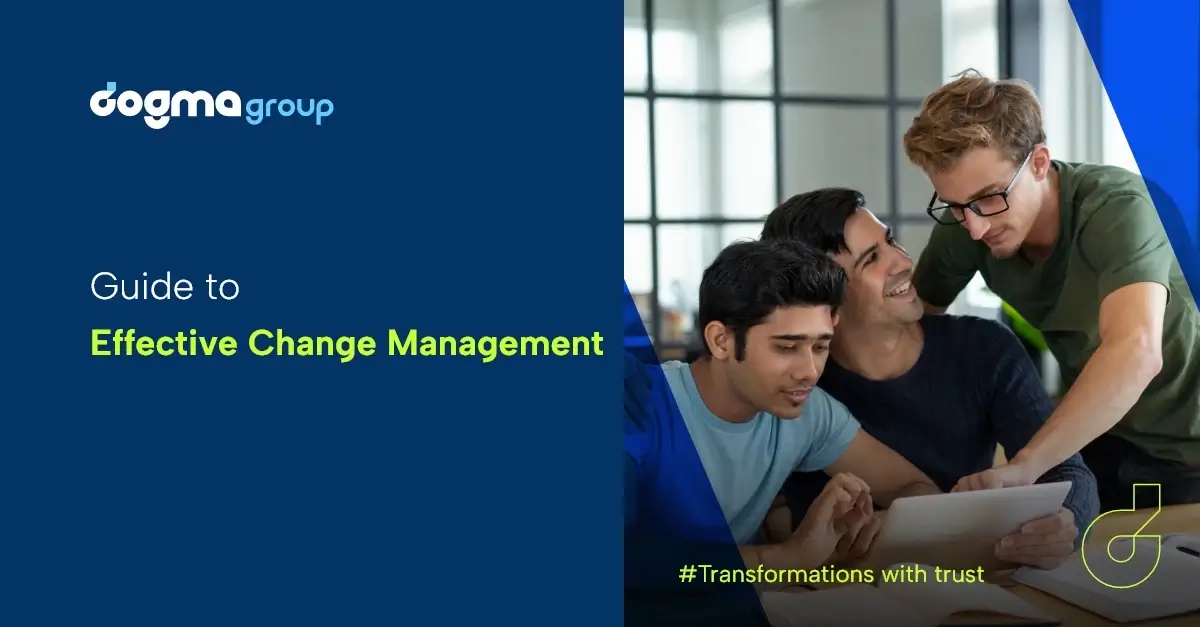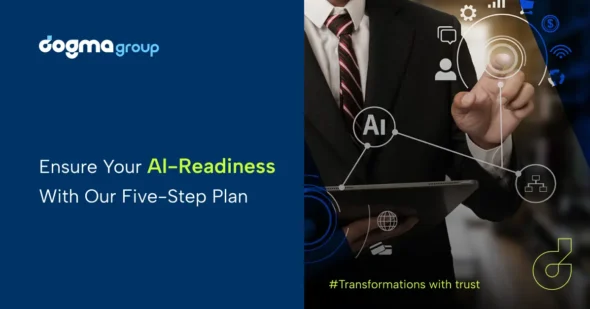According to a report from CRM Side, 22% of all reported problems to successful CRM Implementation were people-related or linked to user adoption. Aside from that, 38% of managers do not like change and this percentage is even higher within their teams.
Taking a new step is what people fear the most. And changing their mindset requires a precise plan that supports long-term results. Sustainable changes can be made more efficient and effective when a well-defined, change management approach is in place.
A proactive organisational change management strategy prepares employees for the change right from the beginning of the project to when the project has gone live with operations.
At Dogma Group, using our change management process based on Prosci, we have helped several organisations execute business and technology changes, which have helped us identify some critical steps for successful change management.
Here are some critical steps to manage implementation of change in an organisation:
Step1- Identify your goals and the areas that need to change
Before you move ahead, consider these questions.
What’s your definition of successful technology implementation? Will your change management strategy bring you closer to your goals? And what are the areas you need to change to achieve your goals?
For example, this can start from the organisational level goals, where you can reflect on where you are right now and envision where you want to be in the next five years. These reflections can get you closer to answering the questions above.
To move closer to your goals, you must first recognise the scope and the areas you need to change. Since change occurs to improve processes and outcomes, it is critical first to clarify the goals and focus on the areas that need to change.
This has two benefits:
- Analysing your goals will help you set a more realistic goal.
- Assessing the areas that need to be changed helps your team understand what needs to be done to achieve success in those areas.
Defining these two areas will give you a clearer idea of what change will look like for your team and help you conceptualise your progress during the process.
Step 2- Define and Analyse impacted groups
Whenever an organisation introduces new technology, this may impact people in different ways. For example, the change may affect their roles, working methods, location, tools and even organisational structure.
That impact affects each group of employees differently, so it is crucial to interact with each group to discuss the change’s impacts, goals, and gaps in the project. These details will form a blueprint for future training, communication and support. The more clearly you articulate and communicate the need and impact of change, the better the outcomes will be.

The key questions here for you to consider in this step are:
- What is the impact of the change on the people?
- How will the change impact each group of people?
- Which group of people will the change affect the most?
- And how will that group receive the change?
Step 3- Identify gaps and manage the resistance
Fear of the unknown is an integral part of technological change. Many times, this reason alone is good enough to make people resist technological changes in an organisation.
Reducing the reluctance for organisational change necessitates the change management team to anticipate and communicate the expected outcome to the group of people impacted by the change.
Integrating resistance management activities in the change management plans is crucial as it drastically improves user adoption. You need to listen to and understand team members’ objections and show them the real and tangible benefits of new technology.
One way to address the reluctance effectively, for instance, is having a one-on-one conversation with each team member. This can often work wonders as team members will get to share their hesitation in person, which, in groups, they might not be able to do. According to Prosci, 70 percent of employees choose their supervisor as their preferred senders of personal message during change. So, the supervisors must be proactive and vigilant in leading their team to help them understand the reasons and benefits of the change.

The conversation can include their performance goals in future, their current state, areas that need to be covered and the ways technology can help them achieve their goals. Other ways to manage the hesitation are hosting interactive training sessions and soliciting employees’ feedback, which could encourage ownership and adoption.
At Dogma, we believe these activities are crucial to driving an outcome-focused change as they help motivate and engage every project stakeholder during all phases of change.
Step 4-Create Plan and Implement Change
Based on your interactions in previous steps, you should be able to determine goals, analyse impacted groups and fully understand the implications of change to the end-users. This helps you develop a change management strategy that outlines the purpose for the change, potential impact areas, the teams and resources required, the timeline and the expected results. Once that is done, you need to put that strategy into action. You then need to create a plan that specifies all the activities required to execute the change. At Dogma, we try to ensure that the plans are based on ADKAR.

According to Prosci, the ADKAR acronym represents five principles of implementing changes successfully: awareness, desire, knowledge, ability, and reinforcement. The ADKAR blueprint sets goals for change management. It has been proven to help people understand and accept why change is necessary so that it can happen successfully and more efficiently.
As your organisation gets used to doing things the new way, it takes time to adjust and measure what is working and what is not. Monitoring the ADKAR outcomes and your change management activities through tracking a calendar are the next highly important tasks in this phase. The change management group then evaluates the team’s strengths and weaknesses.
Following that, the team must plan adaptive activities, implement them, make necessary adjustments and continue monitoring.
Step 5- Sustain the change
Next phase is to make sure that the change actually sticks in your organisation. Humans naturally tend to revert to familiar, old patterns. You need to be mindful that effective change management requires an ongoing commitment for sustainable results. So, established change management plans make reinforcement the final step. According to survey done by Prosci, 61 percent of participants who planned for reinforcement or sustainment activities met and exceeded their project objectives.
If you have just implemented a change in your organisation, let the momentum flow and keep your team proactive. This step requires you to implement actions that ensure users continue the journey to a permanent state of change. Once the change management team takes the necessary action for long-lasting technology adoption, the next step is to prepare and activate roles and transfer ownership to the relevant team members.
Here are few questions to be reflected in this stage.
- What reinforcement methods are used?
- What activities should be done to encourage user adoption?
- How to deal with issue of reinforcing and sustaining change if it requires a repeated review to encourage user-adoption?
Finally, it is important to note that there is no silver bullet to ensure successful change management because people are different and embrace change differently. However, working with an experienced partner like Dogma, you should be able to design change management programs that are risk-free and tailored for your end-users and organisation.

Why choose Dogma for change management?
At Dogma, we understand and engage the stakeholders throughout the project. Dogma will work with your project team to map how the change will impact different functions, stakeholders, and users. We will engage with your teams and team leaders) and review activities to support each stakeholder in the change process. The Dogma team will fully help you establish a well-defined change management program, working parallelly on project management and delivery to facilitate necessary change activities.
Just call us on 01296 328 689 or email us at info@dogmagroup.co.uk for a no-obligation consultation with our change management consultant.






